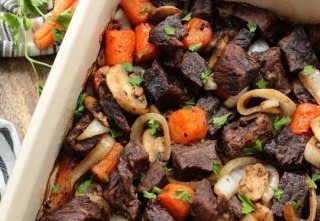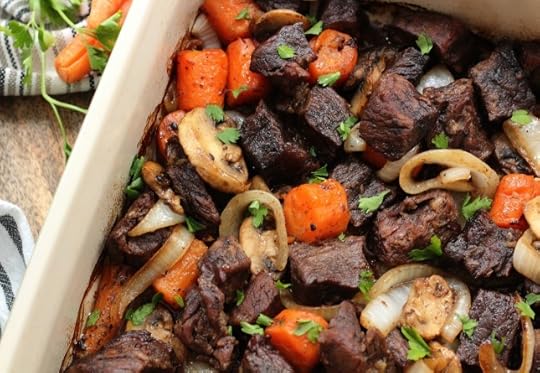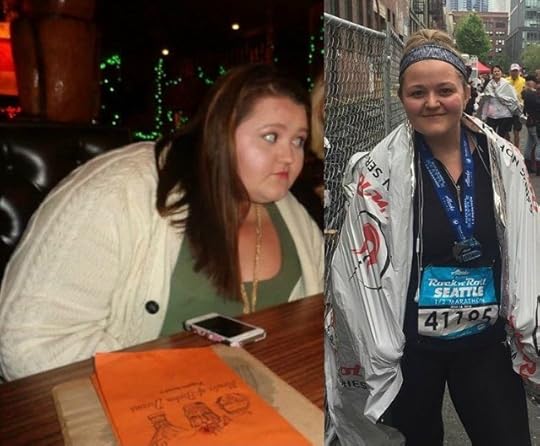Mark Sisson's Blog, page 151
February 25, 2018
Weekend Link Love — Edition 492
 Research of the Week
Research of the WeekToo much fructose in too short a time (glass of juice, can of soda) overwhelms the gut’s ability to handle it, especially on an empty stomach. Eating it after meals helps.
Science journals with the most prestige are often the least reliable.
Once again, very low carb diets are great for Type 2 diabetes (PDF).
A Primal keto diet is just fine for magnesium levels.
New Primal Blueprint Podcasts
 Episode 221: Ken Berry, MD: Host Elle Russ chats with Dr. Ken Berry, a doc using ketogenic diets to treat chronic disease.
Episode 221: Ken Berry, MD: Host Elle Russ chats with Dr. Ken Berry, a doc using ketogenic diets to treat chronic disease.
Each week, select Mark’s Daily Apple blog posts are prepared as Primal Blueprint Podcasts. Need to catch up on reading, but don’t have the time? Prefer to listen to articles while on the go? Check out the new blog post podcasts below, and subscribe to the Primal Blueprint Podcast here so you never miss an episode.
Interesting Blog Posts
Man, desperate to fix his chronic pain, tries jumping into 52° F water for a quick swim. It works.
Why are our teeth so often crooked?
Media, Schmedia
Neanderthals were doing cave art at least 60,000 years ago, just like us.
Maybe don’t go barefoot in San Francisco.
Everything Else
Pandas are beautiful creatures, but man have they been dealt a terrible hand. Despite eating their 99% bamboo diet for thousands of generations, their guts still aren’t designed for fiber fermentation.
Even the wild animals are less free to roam.
Things I’m Up to and Interested In
I’ve always wanted to work a The Graduate reference into the blog: “‘I want to say one word to you. Just one word. Plastics. There’s a great future in plastics if you want to increase the risk of heart disease, type 2 diabetes, hypertension in middle aged and older men.”
I wish they’d figure this out: Cell phone use may still be a problem. Despite recent studies, it’s unclear whether it is or isn’t.
I disagree: “Yoga pants are bad for women.”
I’m laughing because it’s true: “Smells a Bit Like Eggs.”
I’d rave to this: David Attenborough’s voice.
Recipe Corner
Paleo walnut shrimp.
Fried chicken meatballs: Can you imagine anything better?
Time Capsule
One year ago (Feb 25– March 3)
8 Primal Food Challenges You Can Take – Challenge yourself.
How to Move Through Life With an Edge – How and why you should live with purpose, drive, meaning.
Comment of the Week
“Also, how much sulfuraphane did Dana Carvey create on SNL by singing about chopping broccoli?”
– Fantastic reference, Caleb Moline. Here’s the vid.

The post Weekend Link Love — Edition 492 appeared first on Mark's Daily Apple.



February 24, 2018
Paleo Bailey’s Oven Roasted Beef Roast with Caramelized Mushrooms and Onions
 Today’s awesome recipe is served up by Bailey Ryan a.k.a. Paleo Bailey, health blogger extraordinaire, paleo recipe writer, and personal health coach. Yesterday she shared her inspiring story of losing 125 pounds and claiming a new life through healthy living and eating. Today she’s sharing one of her favorite dishes—a perfect comfort food for anytime, I’d say. We’re glad to welcome her back this morning. Enjoy, everyone!
Today’s awesome recipe is served up by Bailey Ryan a.k.a. Paleo Bailey, health blogger extraordinaire, paleo recipe writer, and personal health coach. Yesterday she shared her inspiring story of losing 125 pounds and claiming a new life through healthy living and eating. Today she’s sharing one of her favorite dishes—a perfect comfort food for anytime, I’d say. We’re glad to welcome her back this morning. Enjoy, everyone!
Oven Roasted Beef Roast with Caramelized Mushrooms and Onions
Serves: 6
Time: 75 minutes
Ingredients:
3 pound beef chuck roast, cut into 1 inch chunks
3 large carrots, peeled and cut into 1 inch pieces
2 cups mushrooms, sliced
1 large onion, cut in thin slices
3 tablespoons olive oil
2 bay leaves
2 tablespoons balsamic vinegar
1 and 1/2 tablespoons minced garlic
2 teaspoons onion powder
½ tablespoon salt
2 teaspoons black pepper
Instructions:
Preheat oven to 375 ºF.
In a large baking dish, evenly coat beef and carrots with 2 tablespoons oil, minced garlic, onion powder, salt and pepper. Place bay leaves on top and cover loosely with tin foil, or baking dish lid. Bake for 1 hour.
Before the beef and carrots are done baking, heat 1 tablespoon oil in a pan over medium heat. Add onions and balsamic vinegar, and sauté for 5 minutes. Once they begin caramelizing, add mushroom to the pan. Continue sautéing both onions and mushrooms until done, about 10 more minutes. Add an additional tablespoon of oil and balsamic if needed.
Remove baking dish from the oven, add onions and mushrooms and stir to mix in with the beef and carrots. Place tin foil back over baking dish, and bake for an additional 15 minutes. Remove from oven, stir and enjoy!

 Bailey spent the last 2 years changing her relationship with food and herself. She lost 120 pounds while working 12-hour overnight shifts in a Minneapolis hospital and is now living a “whole” new life. She shares it all on her Instagram, @paleobailey and writes about healthy living, easy yet delicious recipes, and the ups and downs as she navigates finding overall wellness on her blog www.paleobailey.com.
Bailey spent the last 2 years changing her relationship with food and herself. She lost 120 pounds while working 12-hour overnight shifts in a Minneapolis hospital and is now living a “whole” new life. She shares it all on her Instagram, @paleobailey and writes about healthy living, easy yet delicious recipes, and the ups and downs as she navigates finding overall wellness on her blog www.paleobailey.com.
Bailey Ryan
www.paleobailey.com | IG: @paleobailey

The post Paleo Bailey’s Oven Roasted Beef Roast with Caramelized Mushrooms and Onions appeared first on Mark's Daily Apple.



February 23, 2018
Paleo Bailey: I Knew This Couldn’t Be How My Life Was Meant To Be Lived
It’s Friday, everyone! And that means another Primal Blueprint Real Life Story from a Mark’s Daily Apple reader. If you have your own success story and would like to share it with me and the Mark’s Daily Apple community please contact me here. I’ll continue to publish these each Friday as long as they keep coming in. Thank you for reading!

Today’s amazing success story is offered up by a special guest: Bailey Ryan, a.k.a. Paleo Bailey—health blogger extraordinaire, paleo food writer, and personal health coach. She’s joining us today to share how she found Mark’s Daily Apple, lost 125 pounds and claimed a new life in the process. Be sure to check back tomorrow, too, when she shares one of her favorite Primal-friendly recipes—a comfort food dish that’s perfect for this weekend’s family dinner. I’m thrilled she’s joining us today.
At 22-years-old, and just 7 pounds shy of 300 pounds, I was completely miserable. I was out of breath just walking into work, had started avoiding any social or family gatherings, and was completely out of control with my binge eating. I knew that this couldn’t be how my life was meant to be lived, and I knew I would be dramatically shortening my life by continuing down the path I was on.
Mark’s Daily Apple came into my life as I was nearing the end of my first Whole30®. I had never even heard the term Paleo before. By random chance, my best friend told me about Whole30 one day, and with nothing else to lose I decided to try it with her. As we were getting closer to the end of it I couldn’t believe how good I felt. It wasn’t really about the weight at that point, as I was still almost 300lbs. I just had finally caught a glimpse of how feeling good really felt and finally realized how feeling crappy had just been “normal” for me for YEARS.
I have been overweight since early childhood, and this had been the first time in my life I didn’t feel controlled by food. I didn’t have any idea what to do after Whole30, but I knew going back to my old habits weren’t an option. The Whole30 wanted me to reintroduce foods, but I also recognized I had way too many food issues (binge eating, lack of knowledge, compulsive tendencies) and that reintroduction wasn’t going to work for me and that I needed more time.
Again, I didn’t know Paleo was a thing at this point, so I started researching “after whole30” and “healthy grains,” because I thought things like quinoa, wheat bread and low-fat yogurt should be something I eat—again, lack of knowledge of widely accepted “health food.” Both of those searches, and many others, popped up with Mark’s Daily Apple. His words, research, and practical advice was what helped me realize I can make this into a long-term lifestyle, and I didn’t have to keep living like I had a death wish.

I ordered The Primal Blueprint. You should see my first copy. It’s got sticky notes and tabs, and I still refer back to it often. It was basically my bible my first year of eating Paleo and working to reverse some of my food issues that partly were influenced and perpetuated by the societal norms in the current food industry. It gave me a sense of community and a guide to feeling the best I could. I went from being totally in the dark in terms of how to live my best life, to educating and empowering myself to actually do so.

Since then, I’ve not only lost the weight, but I feel like I’ve been given a whole new life. I cried when I went kayaking, because for the first time ever I was under the weight limit. I can rock climb, run half marathons, travel oversees alone and hike mountains in Italy, something I never would have mentally or physically done at 300 pounds. I enjoy spending time with people again because I’ve stopped trying to shrink myself down whenever I was in a room full of people. I started treating myself like I was worth it, and now I’ve realized that I was all along.

 Bailey spent the last 2 years changing her relationship with food and herself. She lost 120 pounds while working 12-hour overnight shifts in a Minneapolis hospital and is now living a “whole” new life. She shares it all on her Instagram, @paleobailey and writes about healthy living, easy yet delicious recipes, and the ups and downs as she navigates finding overall wellness on her blog www.paleobailey.com.
Bailey spent the last 2 years changing her relationship with food and herself. She lost 120 pounds while working 12-hour overnight shifts in a Minneapolis hospital and is now living a “whole” new life. She shares it all on her Instagram, @paleobailey and writes about healthy living, easy yet delicious recipes, and the ups and downs as she navigates finding overall wellness on her blog www.paleobailey.com.
Bailey Ryan
www.paleobailey.com | IG: @paleobailey

The post Paleo Bailey: I Knew This Couldn’t Be How My Life Was Meant To Be Lived appeared first on Mark's Daily Apple.



Primal Starter: Is Your Night Routine Encouraging Fat Storage?
 “Today, instead of experiencing a mellow and graceful transition to sleepiness during the evening hours, our exposure to artificial light after sunset kicks off a chain reaction of adverse hormonal events. Artificial light and digital stimulation after dark suppress the release of melatonin, the hormone that makes us feel sleepy in the evening (a process known as dim light melatonin onset, or DLMO). In tandem, we experience a spike in the primary stress hormone cortisol. Initially, cortisol floods the bloodstream with glucose, giving us a ‘second wind’ to stay awake and finish our emails or Netflix series binge.”
“Today, instead of experiencing a mellow and graceful transition to sleepiness during the evening hours, our exposure to artificial light after sunset kicks off a chain reaction of adverse hormonal events. Artificial light and digital stimulation after dark suppress the release of melatonin, the hormone that makes us feel sleepy in the evening (a process known as dim light melatonin onset, or DLMO). In tandem, we experience a spike in the primary stress hormone cortisol. Initially, cortisol floods the bloodstream with glucose, giving us a ‘second wind’ to stay awake and finish our emails or Netflix series binge.”
Thus, if you stress yourself in this manner every night, chronically elevated evening cortisol can bind with the appetite receptors in the brain and trigger you to consume high-calorie foods. Late nights also dysregulate ghrelin (spiking appetite) and leptin (promoting fat storage). Indeed, our digestive systems also have a circadian rhythm, and eating late at night can mess things up…making it likely that you’ll eat beyond feeling satisfied and store those calories as fat.”
—From The Keto Reset Diet
The post Primal Starter: Is Your Night Routine Encouraging Fat Storage? appeared first on Mark's Daily Apple.



February 22, 2018
Restless Legs Syndrome: Causes, Factors and Treatments
 For anyone who’s experienced it, the frustration can be miserable. The countless tossing and turning, the minutes that tick by (turning into hours), and you STILL haven’t gotten a modicum of decent sleep. No matter how hard you try to ignore it, that urge to constantly move or stretch your legs just won’t let up.
For anyone who’s experienced it, the frustration can be miserable. The countless tossing and turning, the minutes that tick by (turning into hours), and you STILL haven’t gotten a modicum of decent sleep. No matter how hard you try to ignore it, that urge to constantly move or stretch your legs just won’t let up.
Restless legs syndrome (RLS), aka Willis-Ekbom disease, affects a decent chunk of the population: thought estimates vary wildly, this 2017 representative survey places its prevalence between 5.7 and 12.3% of the population. That’s up to around 40 million people in the U.S. alone who go to bed every night knowing they’ll likely be kept awake for hours with that unrelenting, restless sensation.
Conventional RLS Treatments
For people suffering from moderate to severe RLS, pharmaceuticals like dopamine agonists, Alpha-2-delta ligands, opioids, anticonvulsants, and benzodiazepines are often prescribed.
Dopamine agonists operate under the assumption that RLS is linked to impaired dopamine function in the brain. While they do tend to produce good results in the short term, even at low doses they’re also notorious for augmentation, a scenario in which RLS symptoms actually worsen from taking the drug. They’re also commonly associated with an increased risk of impulse control disorders, like pathologic gambling, compulsive eating, and compulsive shopping. Not ideal.
Other common first-line treatments include alpha-2-delta calcium channel ligands, and in some cases, opioids. Alpha-2-delta ligands are often effective in treating RLS that occurs in tandem with painful peripheral neuropathy, certain forms of chronic pain, and even Parkinson’s disease; however, they’re also linked to depression and suicidal tendencies. Also not ideal. And then there are opioids. Whether they’re a viable treatment for RLS or not, they may undoubtedly introduce more problematic side effects and addictions than they’re worth for many people.
Nutritional and Medical Factors Related to RLS
Magnesium
Magnesium, which most of us are seriously lacking, interacts with calcium in the body to help regulate the nerves and muscles. When serum magnesium levels are low, nerve cells become overactive and can get a bit trigger happy in sending messages to our muscles. The result is constant muscle contraction, which explains many of the symptoms of restless legs syndrome.
In a small study involving patients with mild to moderate RLS, oral magnesium every evening for 4 to 6 weeks improved symptoms in all patients. Another study involving a pregnant woman given intravenous magnesium sulfate for 2 days indicated complete recovery from RLS symptoms. Magnesium is considered “investigational” by a larger review study, but research is scant.
Despite the apparent lack of research on the link between RLS and magnesium deficiency or supplementation, there’s still a decent amount of positive anecdotal evidence. If you’re magnesium deficient, it’s worthwhile trying a magnesium supplement given it’s support for other elements of health. Some people chose chelated forms like magnesium glycinate, but others swear by transdermal magnesium and magnesium citrate.
Iron
Unlike magnesium, the link between iron deficiency and RLS has received plenty of attention in the literature. This 2007 study showed that RLS sufferers with low serum ferritin were more likely to experience an iron deficiency in the central nervous system. This, in turn, impedes dopamine signaling, the result of which is greater risk of RLS. A 2013 study verified these findings by using MRI to show that RLS sufferers have significantly lower iron content within several areas of the brain.
Considering the importance of iron for healthy dopamine signaling, the results make sense. And several studies have shown that RLS patients with low serum ferritin (generally less than 75 mcg/L) have responded well to both oral and intravenous iron.
Of the two dosages, oral iron supplementation is by far the safest and easiest, especially when combined with vitamin C. That being said, it’s important to get your ferritin levels checked at least every 3 to 4 months during oral iron supplementation to ensure you don’t go overboard, since excess iron imposes health risks.
Vitamin D
Like iron, vitamin D appears to play a key role in dopamine synthesis and metabolism, meaning those who are deficient are more likely to experience RLS symptoms. A 2014 study showed that presence of RLS was significantly higher in vitamin D-deficient patients, while a 2015 study found that certain variations in the vitamin D3 receptor gene were associated with an increased risk of RLS.
Luckily, vitamin D treatment is a fairly straightforward affair, and it seems to yield good results for those dealing with RLS. One recent study showed that vitamin D3 treatment (oral or intravenous) in those who were deficient was able to improve symptoms from a median RLS severity score of 26 down to 10. While this impressive result hasn’t necessarily been reflected across the board, it suggests that vitamin D supplementation is worth a shot if you suffer from RLS. For most people (particularly in winter), it’s worth upping your vitamin D levels whether you’ve got RLS or not.
Alcohol
There isn’t a lot of research to support the association between alcohol and RLS, but plenty of anecdotal evidence suggests it’s worth exploring. Alcohol can otherwise lower sleep quality and increase conditions of sleep apnea, which in turn can contribute to worsening of RLS symptoms. In a European study spanning close to 19,000 people, those who drank at least 3 alcoholic beverages a day were more likely to have RLS. Even if that tops your usual imbibing, alcohol probably isn’t helping your restless legs.
SIBO and Other Gut Disorders
Whether you’re low in iron or not, it’s worthwhile considering the link between gut conditions like small intestinal bacterial overgrowth (SIBO) and restless legs syndrome. A 2011 study of 32 RLS subjects found that 69% of RLS sufferers had SIBO, compared to only 28% of healthy controls. As part of the same study, another 28% of RLS subjects had irritable bowel syndrome (IBS) compared with just 4% of controls. A Japanese study of 80 outpatients diagnosed with inflammatory bowel disease (IBD) found that 20% of them also suffered from RLS. In another study involving 272 Crohn’s disease outpatients, RLS prevalence was 30%, and 43% had suffered from RLS at some point in the past. Celiac disease has much the same relationship with RLS, with 1 in 4 celiacs also reporting RLS symptoms.
Conventional treatments for IBS patients have shown dramatic improvements in RLS symptoms, but this generally involves a heady dose of antibiotics. A more Primal-friendly course of action would involve regular use of a good quality probiotic and a low-FODMAP diet until your RLS symptoms improve. Here’s what I use.
Autoimmune and Inflammatory Diseases
It might seem like highlighting the association between RLS and both autoimmune and inflammatory disease states is something of a catch-all, but the fact remains that people with conditions like Parkinson’s disease, Alzheimer’s disease, Celiac disease, MS and rheumatoid arthritis are far more likely to suffer from RLS than healthy individuals. A literature review found that out of 47 RLS-associated conditions, 42 of them had an autoimmune or auto-inflammatory component. Another study published last year also found strong links between patients’ neutrophil-to-lymphocyte ratio, a key marker of systemic inflammation, and RLS.
As far as specific treatments go, this is where things get tricky and individualized. How you approach the problem depends on your inflammatory or immune condition, but improvements can almost always be achieved by adopting an anti-inflammatory, Primal type of diet. You know, one loaded with nutrient-dense, whole foods and relatively devoid of inflammatory foods. Adjusting lifestyle factors to reduce stress and increase movement and sleep will also make a huge difference, but more on that next.
Other Factors For Treating RLS
Stress
As far as nonpharmaceutical measures go, one of the most successful RLS treatments is simply to reduce stress. That means, of course, eliminating causes of stress in your life where possible, but healthy practices that ameliorate its impact are a good idea, too.
For example, in a 2012 study, 13 women with moderate to severe RLS were placed on an 8-week self-guided Iyengar yoga program. At the end of the 8 weeks, “participants demonstrated striking reductions in RLS symptoms and symptom severity, with symptoms decreasing to minimal/mild in all but 1 woman and no participant scoring in the severe range by week 8.” Another study published last year combined yoga with aerobic exercise for 12 weeks to see significant improvements in RLS symptoms—to the point where patients were able to reduce their dosages of the RLS drugs they were on.
If yoga isn’t your thing, there’s plenty of other stress-alleviating options. Getting out into nature, using guided meditation, trying an adaptogen supplement (with your doctor’s okay), and even watching a good comedy can all chip away at the stress we feel.
Medications
Certain medications have been shown to contribute to higher risk and severity with restless legs syndrome. A literature review of applicable studies found that antidepressants, neuroleptic agents, dopamine-blocking antiemetics, and sedating antihistamines have a strong correlation to incidence and greater severity of RLS, and where possible should be avoided. Obviously, this isn’t always an option, but it’s worth exploring whether a substitution can be made. As always, discuss your concerns with your doctor before discontinuing any medication.
Exercise
A 12 week trial involving 28 participants showed that aerobic and lower body resistance training produced significant improvements in RLS symptoms across the board. A smaller study found similar results, with aerobic exercise over the course of 16 weeks producing an average reduction in RLS severity of 42%.
Stretching has also been shown to improve RLS symptoms, so consider doing some light leg stretches before bed or when the restless legs hit.
Compression Devices
While a trifle inconvenient and decidedly uncomfortable, compression devices show some serious promise in treating RLS. A 2009 study had 35 subjects wearing either a therapeutic compression device or sham device for at least an hour a day for 1 month. After 1 month, the compression group saw significant reductions in RLS symptoms, with an almost 50% reduction in severity. Another study involving 10 RLS patients saw 1 patient pull out of the protocol due to discomfort, but the remaining 9 used a compression device for 1 to 3 months and saw either complete remission of RLS or a marked improvement in symptoms. Obviously, if the need is great, compression devices are worth considering.
Beyond traditional compression accessories, however, more comfortable measures like weighted blankets may offer relief for some people. Those without RLS may find they sleep better with them, too.
Pregnancy
An estimated 1 in 5 women experience RLS during pregnancy. And although RLS symptoms usually recede shortly after delivery, it can make sleep more difficult during pregnancy and even pose its own health risks.
Generally speaking, many of the non-pharmacological treatments outlined above are effective in reducing the symptoms of pregnancy-related RLS. It’s always a good idea to get regular blood tests, as low iron levels (a common contributor to RLS) are a common occurrence in pregnant women. Other risk factors for RLS during pregnancy include vitamin D deficiency, impaired calcium metabolism, and a lack of low-impact exercise. Address these factors, and you’re bound to see a difference.
Thanks for reading, folks. For those of you with RLS, what’s worked (and hasn’t worked) for you? Share your thoughts below.
The post Restless Legs Syndrome: Causes, Factors and Treatments appeared first on Mark's Daily Apple.



Primal Starter: Meeting the Wild Within
 Over the course of a day’s hike or in a sudden wonderstruck moment, many of us have felt the edges of our selves dissolve into the wild that surrounds us. We become unconsciously “of” our environments. Shedding the insular, constraining cages of our everyday hyperrationality—the mental chatter, the rigid expectations, and inevitable tension and failures that accompany them—identities and desires evaporate into the senses. For a time, we become raw awareness. The heightening of the senses alone can feel like a kind of animalistic thrill.
Over the course of a day’s hike or in a sudden wonderstruck moment, many of us have felt the edges of our selves dissolve into the wild that surrounds us. We become unconsciously “of” our environments. Shedding the insular, constraining cages of our everyday hyperrationality—the mental chatter, the rigid expectations, and inevitable tension and failures that accompany them—identities and desires evaporate into the senses. For a time, we become raw awareness. The heightening of the senses alone can feel like a kind of animalistic thrill.
For our ancestors, the natural world was mystically animated in ways we moderns have a hard time grasping. Today we’re guided more by scientific interpretations of nature and the prevailing metaphysical and monotheistic religions that seat spiritual figures in the otherworldly.
For our hunter-gatherer and early “ancient” ancestors, however, the natural world was the seat and center of spiritual force. The earth was their cosmological stage for the game of life, whose essential figures encompassed many species and whose plot lines were always in the present, spontaneous making. Everything from animal encounters to a season’s weather were part of a mystical dance between people and the forces of creation. Spiritual life was life itself, and vice versa. In the words of the ancient Greek philosopher Thales, “Everything is full of gods.”
Of course, this enchantment came hand in hand with superstition and all of its limitations. Although today we have generations’ worth of scientific insight, we nonetheless still crave that sense of connection and, as Jung and others have called it, “original knowing.” We’re naturally inclined to seek “spiritual” or (in less metaphysical terms) transcendent experience in the wild. These encounters fill some essential hunger in our deeper psychic layers.
In this sense, spiritual experiences in nature aren’t so much about witnessing something of the natural world itself but rediscovering something in ourselves—perhaps the “wilderness within,” as author Paul Shepard calls it. Our encounters are rare moments of deep spiritual consonance, a comforting, vital harmony within our most fundamental natures. Humans, after all, have both the gift and the hardship of living between two worlds—that of the wild that nurtured them and that of the cultures they create. More and more, the two realms grow further apart in our modern age. These spiritual experiences in wilderness perhaps embody a homecoming of sorts and offer balm for the deep homesickness that accompanies our social and cultural progress.
For more, read the past post, “Spiritual Encounters in Nature.”
The post Primal Starter: Meeting the Wild Within appeared first on Mark's Daily Apple.



February 21, 2018
Does the Fasting Mimicking Diet Live Up to the Hype?
 Valter Longo is a leading fasting researcher. Since the early 2000s, he’s been one of the top guys running legitimate fasting studies in cancer patients, regular people, and, of course, rodents. He’s gotten great results, elucidating the idea that fasting causes human cells and tissues to enter “survival mode” which allowed them to survive the withering effects of cancer treatment. I’ve cited many of his studies in previous posts.
Valter Longo is a leading fasting researcher. Since the early 2000s, he’s been one of the top guys running legitimate fasting studies in cancer patients, regular people, and, of course, rodents. He’s gotten great results, elucidating the idea that fasting causes human cells and tissues to enter “survival mode” which allowed them to survive the withering effects of cancer treatment. I’ve cited many of his studies in previous posts.
Several years ago, he came up with an “easier” way to induce the fasting effect in people: the Fasting Mimicking Diet (FMD). Instead of having people skip food altogether—which may not sound crazy to readers of this blog, but probably does to most people—he designed a low-calorie 5-day diet for people to follow at periodic points throughout the year. Longo thinks the FMD is the best way for people to reduce their risk of aging-related diseases, extend lifespan, and live healthier, longer lives. It’s designed to give cancer patients and other people access to the benefits without the mental deprivation that often accompanies true fasting.
The 5-day FMD is a low-protein, high-moderate-carb, moderate-fat diet.
The first day is 1090 calories, with 10% from protein (27 grams), 56% from fat (68 grams), and 34% from carbohydrates (93 grams).
The next four days are 725 calories, with 9% protein (16 grams), 44% fat (35 grams), and 47% carbohydrates (85 grams).
Most of the fat is polyunsaturated and monounsaturated. The protein is plant-based. The carbs come from nuts, seeds, legumes, and grains.
He even came up with a shelf-stable package of FMD food called ProLon. Instead of weighing and measuring your carrots and mac nuts and olives, you could just buy the 5-day supply of dry food and be on your merry way.
It’s certainly an attractive idea—a shortcut to fasting.
Does it live up to the hype? Does it truly improve lifespan in humans?
There’s certainly nothing wrong with it. Let’s get that off the table. It’s a fine idea. Certainly better than what most people do.
I just don’t know if it offers unique benefits to healthy people interested in extending their lives that other eating plans, like keto or Primal or intermittent fasting, don’t offer.
Let’s take a look at some of those benefits.
In rodents, the FMD has been shown to do some pretty cool things:
Improve lipids numbers.
Reduce body weight (and fat).
Activate autophagy.
Rejuvenate damaged organs, like the pancreas in type 1 diabetes.
Reduce cancer occurrence.
Extend life.
The one human trial, done last year, also got positive results.
Improved lipids.
Reduced body fat and body weight.
Lower blood pressure.
Lower fasting glucose.
Reduced CRP, a marker of inflammation.
Reduced IGF-1, insulin-like growth factor.
But there are some issues with the human study.
The subjects weren’t quite healthy at baseline. They were “generally” healthy, and there’s a difference. Over half were obese or overweight. The average body fat percentage was 34%. No one was about to keel over, but these weren’t lean, athletic types.
We don’t quite know what they ate before starting the trial, but the average American doesn’t have a great track record when it comes to dietary quality. They may very well have been going from a standard American diet full of junk food to the healthier approach promoted by the researchers.
They got healthier. They lost weight and body fat. Their biomarkers improved, suggesting a reduction in risk for some of the diseases that characterize aging. That’s real. But it’s also not unique to the fasting mimicking diet.
Furthermore, the people who were the most overweight and unhealthy at baseline reaped the greatest benefits. The lean, healthy people saw fewer benefits, which is understandable—they had fewer problems to solve.
The meatiest results came in rodent studies. The human study shows that overweight and obese folks can really benefit from the proprietary fasting mimicking diet, but that’s about it. It doesn’t show increased lifespan (study was too short). It doesn’t show organ rejuvenation (didn’t measure). It doesn’t show reversal of type 2 diabetes (didn’t try). All those things could very well happen in humans, and I wouldn’t be surprised—but for the time being, those effects have only been shown in rodents. We are not rodents, as I’ve made explicitly clear before and you can hopefully surmise from your own lived experience.
I see another major problem to Longo’s approach and the crux of his argument: It’s predicated on the idea that lower IGF-1 is a Good Thing.
Older folks with lower IGF-1 levels have a lower risk of cancer. That’s true. That’s important, assuming the connection is causal. There’s good reason to believe that it is.
IGF-1 participates in the etiology of ovarian cancer, is involved in breast cancer, helps sustain cancer cell viability, and affects the prognosis of non-small-cell lung cancer, just to name a few. As a growth-promoter, IGF-1 has the potential to promote the growth of cancer cells.
But IGF-1 levels also have a curious association with all-cause mortality. It’s U-shaped, meaning both super low levels and super high levels are linked to increased mortality risk, and that there’s a sweet spot somewhere between where IGF-1 is helping, not hurting. Lower isn’t always better. Somewhere in the middle is the best for longevity.
And for quality of life and overall health, IGF-1 does some good things after all. We don’t manufacture it in order to kill ourselves.
Resistance training, for example, spikes IGF-1. The increase in IGF-1 actually mediates the increase in strength—the beneficial adaptation to the training. Is Longo or any other longevity researcher going to suggest that lifting weights is bad for lifespan and health? (Oh, I’m sure there’s someone…)
IGF-1 counters age-related muscle wasting. I can’t think of a more important physical characteristic for older adults than lean muscle mass.
IGF-1 builds bone strength. Older women with higher IGF-1 levels have stronger bones, and IGF-1 is necessary for bone formation. This goes hand in hand with increasing muscle strength, as resistance training famously builds both muscle and bone.
IGF-1 is necessary for metabolic health. When you inject type 2 diabetic patients with IGF-1, their blood sugar drops, insulin sensitivity increases, and lipids improve.
Dying from cancer is awful. Dying in general, from any number of other maladies, is also bad. We can all agree that we want less of both types of death. We also want good muscle strength, bone mass, metabolic function, and all the rest.
Perhaps I’ve come off a bit too harsh on FMD. I don’t intend to. Longo is a great researcher, and the fasting mimicking diet obviously works. Where I take issue is the assertion that it is uniquely beneficial for longevity and health, or that “lower IGF-1” is what we should all be striving for. That simply hasn’t been proven. It may be true.—but I suspect the reality is far more complex than that.
Thanks for reading, folks. Take care, and be sure to let me know what you think about the FMD down below!
Want to make fat loss easier?
Try the Definitive Guide for Troubleshooting Weight Loss for free here.
The post Does the Fasting Mimicking Diet Live Up to the Hype? appeared first on Mark's Daily Apple.



Midweek Quick Cooking: Chocolate Collagen Hot Cocoa
 Midweek means fast and simple ideas for good Primal eating, and this Chocolate Collagen Cocoa from the Primal Kitchen blog is the perfect antidote to the February chill. With the health-boosting effects of collagen—including enhancing skin’s elasticity and improving joint resilience—as well as the nutritional goodness of other whole food ingredients, this treat is a great way to warm up your morning—or afternoon.
Midweek means fast and simple ideas for good Primal eating, and this Chocolate Collagen Cocoa from the Primal Kitchen blog is the perfect antidote to the February chill. With the health-boosting effects of collagen—including enhancing skin’s elasticity and improving joint resilience—as well as the nutritional goodness of other whole food ingredients, this treat is a great way to warm up your morning—or afternoon.
Ingredients
1 scoop Primal Kitchen® Chocolate Collagen Fuel
2 Tbs raw/organic cocoa powder
1 can full fat coconut milk* (or 2 cups homemade nut milk)
Optional: 1 teaspoon honey
*Save the coconut cream as a “whipped cream” topping
Instructions
Blend ingredients together.
Top with coconut “whipped cream” (optional)
Enjoy!
For more great recipes (including a delicious Vanilla Collagen Fuel Latte), check out the Primal Kitchen blog.
The post Midweek Quick Cooking: Chocolate Collagen Hot Cocoa appeared first on Mark's Daily Apple.



February 20, 2018
10 Basic Human Skills the Younger Generation Isn’t Learning
 There are many reasons to be thankful for the cushy existence modernity affords us. War and other extenuating circumstances aside, you probably don’t fear for your life on a daily basis. You have clean water to drink. Food is widely available, and it’s affordable. You survived infancy, childhood, and adolescence, which is quite special on a historical scale.
There are many reasons to be thankful for the cushy existence modernity affords us. War and other extenuating circumstances aside, you probably don’t fear for your life on a daily basis. You have clean water to drink. Food is widely available, and it’s affordable. You survived infancy, childhood, and adolescence, which is quite special on a historical scale.
But there are downsides. Food has gone industrial. We increasingly live our lives in the digital realm and ignore the physical. Perhaps the most recent change relative to that shift has been the physical neutering of our kids. This has happened more broadly across all ages as countries shift away from manual labor toward more of an information economy, but it’s become incredibly pronounced in the generation coming up. At least when I grew up kids still wandered the streets in search of adventure, testing themselves out physically, undergoing mental and physical challenges, breaking bones and straining muscles, and learning about movement from the best teacher of all—hands on experience. Now? The lucky ones will get gymnastics or martial arts or dance training a couple days a week. But most languish indoors, prevented from the kind of free-form exploratory play human children have enjoyed for thousands of generations.
What are they losing? What physical skills —basic human abilities—will they lack?
Throwing
The recent complaint from an Army general illustrates this nicely: New recruits are so terrible at throwing grenades that they’ve nixed the requirement for graduation altogether. And it’s not just a strength thing, although I’d imagine that’s often a problem. It’s a technique thing. They didn’t grow up throwing.
Throwing on a regular basis when your brain is still developing establishes stronger neural pathways that persist into adulthood. It’s why learning languages and riding bikes “sticks” more when you do it as a kid. Throwing is no different.
Throwing is a human universal. Hell, the ability to lead a target, to subconsciously triangulate all the variables and figure out where to throw in order to hit the running antelope (or streaking wide receiver) is uniquely human. It may have made being human possible. We have those long arms, hyper mobile shoulders, upright postures, big brains, and powerful posterior chains that allow us to generate incredible power on and accuracy with our projectiles.
Weighted Carries
Twenty thousand years ago, we carried foraged and hunted food incredible distances on a regular basis. Two thousand years ago, we wore a hundred pounds of kit on months-long military campaigns. One hundred years ago, we carried slop out to the hogs and pitched hay bales. Fifty years ago, I lugged wheelbarrows of dirt around the yard helping my dad with the garden.
Today, kids carry their mandatory iPad to school and complain when Mom or Dad tries to get them to help with yard work.
Balancing
The world is unstable. Things teeter. They get wet and slippery. Sometimes the walking surface is too narrow for our feet, or for more than one foot at a time. We need to be able to traverse it safely and effectively.
Ideally, kids should seek out these unstable, narrow surfaces. Park bench? They should hop on and walk along the back. Curb? Way better than a sidewalk. But their attention is elsewhere, and I think it’ll come back to bite them in the future.
Climbing
I did a lot of impromptu climbing as a kid. And not just large rocks, trees, and mountains. I’d climb fences, so many fences. There were multiple ways to scale a chain link fence. My favorite was going head first and flipping over onto my feet followed closely by perching along the top and jumping down.
Can’t recall the last time I saw a kid climb a fence, let alone a tree. Climbing gyms are growing, so there’s a real desire for it. Rock climbing is a different beast though. It’s more methodical and strategic. What I’m interested in is the ability and confidence to just get over barriers. You see an obstacle. You climb it, without really thinking or planning. There’s a metaphor in there somewhere.
Jumping
Jumping is an act of faith. In your own abilities. In the stability of the landing surface.
You can see it in kids who’ve never quite jumped before. They approach the edge, look down, look over at you, look back down. They pump their bodies, priming for the jump. Their eyes get a glint of anticipation. They know it’s a big thing, the first jump. A momentous occasion. Then they leap, and it works, and they’re hooked. They’re believers.
A jump is an explosive hip extension, utilizing the glutes and hamstrings. You know, the muscle groups that grow flabby and atrophied when we sit down all the time.
Landing
The most important part of jumping is the landing. Landing correctly protects your joints from injury and allows you to smoothly transition into the next movement (running, jumping again, dodging). It’s a foundational skill for most sports and non-sport athletic endeavors, like dancing or parkour.
How many broken hips, sprained ankles, and knee injuries are coming down the line for future adults who never learned how to land a simple jump?
Rock Scrambling
Bouldering is great and all. Rock climbing is fun. But my favorite thing to do on and around large deposits of rocks and minerals is scramble up and down them. You go without any equipment. No special shoes. No fanny pack full of chalk. No ropes. And unlike the insane free climbers, no real risk of death and dismemberment.
Rock scrambles get you into situations hairy enough to get your blood pumping and force you to reckon with your own mortality, but manageable enough that you can usually get out without adult assistance. That’s a huge thing for kids to experience—the realization that life can be dangerous and risky while still worth doing.
Creek Walking
One of my favorite pastimes as a kid was walking up and down creeks by jumping from rock to rock, making sure never to touch ground. We’d sometimes do creeks miles long this way. This is no easy task. You have to be willing to go barefoot (or sacrifice grip and stability and risk getting your shoes filthy). The rocks are slippery and mossy. The water’s cold. And you have to actually go to a functioning creek.
Creek walking forces focus. You can’t sleepwalk your way through a creek walk. Every step is different, presents new challenges. It’s mentally and physically draining.
Stamina
I can’t tell you the number of gangly 5-year-olds I’ve seen being carted around in strollers, legs hanging over the side, face craned toward the tablet in their laps, oblivious to the world occurring around them. Or the kids whining about how “their legs hurt.” One study from 2013 found that today’s kids take a minute and a half longer to run a mile than kids of the same age from 30-40 years ago. How do you think their endurance will be as adults?
The reason why is simple. Kids have fewer opportunities and inclinations to walk. As mentioned earlier, kids aren’t roaming around neighborhoods like they used to. They’re not putting in the miles. The rise of smartphones has also contributed. If part of your daily allotment of hours is dedicated to something entirely novel on the historical timeline—staring into a handheld electronic device—you will necessarily have fewer hours available to do physical things like walking.
Strength
Kids are more likely now to be weaklings than they were twenty years ago. Between 1998 and 2008, ten-year-olds in one British town suffered huge losses in strength:
27% fewer situps
Arm strength dropped by 26%, grip strength by 7%
10% of kids couldn’t hang from a bar, compared to just 5% in 1998
Who wants to bet the problem is even worse today?
This is a problem. Child weaklings grow up to be adult weaklings. Their physical inabilities perpetuate themselves. If physical movement isn’t rewarding because you’re bad at it, get winded easily, and fail at the skills required to excel, you’re less likely to pursue it into adulthood. That’s when the health issues mount, your appearance declines, and things fall apart. A society of physically inept and weak people cannot stand for long.
You don’t “need” these skills to live in today’s world. That’s the whole point, in fact: Kids are coming into adulthood never having needed to learn how to do this stuff. But being able to jump, balance, throw, climb, and walk while carrying heavy loads makes life easier, more enjoyable, and more rewarding. It opens doors. The disappearance of these skills is a tragedy.
But it’s fixable. I’m not calling for rigorous training sessions. Humans are built to do these things. They just have to do them.
What can we do to fix the problem? Are there any other skills today’s younger generations just aren’t developing?
I’d love to hear your thoughts. Take care, everyone.
The post 10 Basic Human Skills the Younger Generation Isn’t Learning appeared first on Mark's Daily Apple.



Primal Starter: Retrospective Truths
 The fact is, life teaches us. I’m not talking just about the collection of data—more information gathered, more studies skimmed. I mean the self-knowledge acquired, sometimes through hard-won means as well as the priorities that have come into focus over time. It’s often about the lessons learned through a variety of epic mistakes and frustrating dead-ends. Beyond the neat world of “good life” theory exists the full dimensional backdrop of living feedback.
The fact is, life teaches us. I’m not talking just about the collection of data—more information gathered, more studies skimmed. I mean the self-knowledge acquired, sometimes through hard-won means as well as the priorities that have come into focus over time. It’s often about the lessons learned through a variety of epic mistakes and frustrating dead-ends. Beyond the neat world of “good life” theory exists the full dimensional backdrop of living feedback.
Still, I wonder what it would mean if we could take certain viewpoints on faith earlier in our lives. Maybe we do once in a while. While you think on how that’s worked in your own life, let me throw out a few pieces of retrospective truths I’ve found or friends and clients have shared over the years.
Let yourself rest more. Seriously, there’s plenty of time.
Find something you really love to do as a way to move every day. Make it something you look forward to – a want rather than a should.
Learn to cook. No, really. Learn to enjoy it. Enjoy experimenting with it. Value your time in the kitchen in a way the culture doesn’t encourage as much anymore. You’ll be healthier for it – and a kick@$$ host.
Pretty much 90% of what you’re stressing about will mean nothing in ten years – most of it nothing in 10 days. Learn to let it go.
Play more. But don’t make it an official, planned, self-conscious exploit: “Hey, I’m going to play now!” Just stop taking your life so seriously. Look for ways you can make everyday life more in the spirit of play – exercise, parenting, work, cooking, etc. Loosen up and embrace your inner fool.
Tithe your time – to yourself, to your own joy.
Look for a job that doesn’t take all your time and energy. Think about the conditions that will make or break your happiness here: long commute – no, long vacation time – yes.
Meditate – not because it’s supposed to be “good” for your health as you get older but because it will help you enjoy your life more exactly where you’re at.
Don’t think of health in terms of components – like add-ons you can incorporate one after the other. Give up the divisions in your life. Live from a healthy center, and make everything else – all your other – choices reflect that value.
What are yours to share? And to read more this morning, check out “What Advice Would You Give Your Younger Self?”.
The post Primal Starter: Retrospective Truths appeared first on Mark's Daily Apple.



Mark Sisson's Blog
- Mark Sisson's profile
- 199 followers





